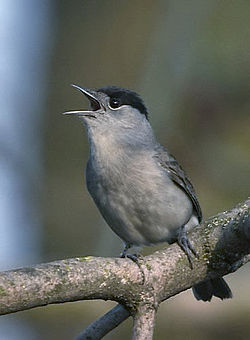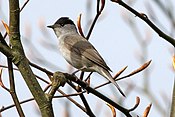Sylviidae
| Sylviidae | |
|---|---|

| |
| Eurasian blackcap (Sylvia atricapilla) | |
| Scientific classification | |
| : | [[Template:Taxonomy/Sylviidae]] Leach, 1820 |
| Genera | |
|
See text | |
Sylviidae is a family of passerine birds that includes the typical warblers and a number of babblers formerly placed within the Old World babbler family. They are found in Eurasia and Africa.
Taxonomy and systematics[edit | edit source]
The scientific name Sylviidae was introduced by the English zoologist William Elford Leach (as Sylviadæ) in a guide to the contents of the British Museum published in 1820.[1][2] The family became part of an assemblage known as the Old World warblers and was a wastebin taxon with over 400 species of bird in over 70 genera.[3] Advances in classification, particularly helped with molecular data, have led to the splitting out of several new families from within this group. There is now evidence that these Sylvia "warblers" are more closely related to the Old World babblers than the warblers and thus these birds are better referred to as Sylvia babblers, or just sylviids.[4]
A molecular phylogenetic study using mitochondrial DNA sequence data published in 2011 found that the species in the genus Sylvia formed two distinct clades.[5] Based on these results, the ornithologists Edward Dickinson and Leslie Christidis in the fourth edition of Howard and Moore Complete Checklist of the Birds of the World, chose to split the genus and moved most of the species into a resurrected genus Curruca, retaining only the Eurasian blackcap and the garden warbler in Sylvia. They also moved the African hill babbler and Dohrn's thrush-babbler into Sylvia.[6] The split was not accepted by the British Ornithologists' Union on the grounds that "a split into two genera would unnecessarily destabilize nomenclature and results in only a minor increase in phylogenetic information content."[7]
List of species[edit | edit source]
The family includes 25 species divided into 2 genera:[8] This list is presented according to the IOC taxonomic sequence and can also be sorted alphabetically by common name and binomial.
| Genus | Common name | Binomial name | IOC sequence |
|---|---|---|---|
Sylvia Scopoli, 1769
|
Eurasian blackcap | Sylvia atricapilla | 1 |
| Garden warbler | Sylvia borin | 2 | |
| Dohrn's warbler | Sylvia dohrni | 3 | |
| Abyssinian catbird | Sylvia galinieri | 4 | |
| Bush blackcap | Sylvia nigricapillus | 5 | |
| African hill babbler | Sylvia abyssinica | 6 | |
| Rwenzori hill babbler | Sylvia atriceps | 7 | |
Curruca Bechstein, 1802
|
Barred warbler | Curruca nisoria | 8 |
| Layard's warbler | Curruca layardi | 9 | |
| Banded parisoma | Curruca boehmi | 10 | |
| Chestnut-vented warbler | Curruca subcoerulea | 11 | |
| Lesser whitethroat | Curruca curruca | 13 | |
| Brown parisoma | Curruca lugens | 15 | |
| Yemen warbler | Curruca buryi | 16 | |
| Arabian warbler | Curruca leucomelaena | 17 | |
| Western Orphean warbler | Curruca hortensis | 18 | |
| Eastern Orphean warbler | Curruca crassirostris | 19 | |
| African desert warbler | Curruca deserti | 20 | |
| Asian desert warbler | Curruca nana | 21 | |
| Tristram's warbler | Curruca deserticola | 22 | |
| Menetries's warbler | Curruca mystacea | 23 | |
| Rüppell's warbler | Curruca ruppeli | 24 | |
| Cyprus warbler | Curruca melanothorax | 25 | |
| Sardinian warbler | Curruca melanocephala | 26 | |
| Western subalpine warbler | Curruca iberiae | 27 | |
| Moltoni's warbler | Curruca subalpina | 28 | |
| Eastern subalpine warbler | Curruca cantillans | 29 | |
| Common whitethroat | Curruca communis | 30 | |
| Spectacled warbler | Curruca conspicillata | 31 | |
| Marmora's warbler | Curruca sarda | 32 | |
| Dartford warbler | Curruca undata | 33 | |
| Balearic warbler | Curruca balearica | 34 |
Description[edit | edit source]
Sylviids are small to medium-sized passerine birds. The bill is generally thin and pointed with bristles at the base. Sylviids have a slender shape and an inconspicuous and mostly plain plumage. The wings have ten primaries, which are rounded and short in non-migratory species.[3]
Distribution and habitat[edit | edit source]
Most species occur in Asia, and to a lesser extent in Africa. A few range into Europe.
References[edit | edit source]
- ↑ Leach, William Elford (1820). "Eleventh Room". Synopsis of the Contents of the British Museum. Vol. 17 (17th ed.). London: British Museum. pp. 66–67. The name of the author is not specified in the document.
- ↑ Bock, Walter J. (1994). History and nomenclature of avian family-group names. Bulletin of the American Museum of Natural History Issue 222. pp. 152, 245. hdl:2246/830.
- ↑ 3.0 3.1 Bairlein, F.; Bonan, A. "Old World Warblers (Sylviidae)". In del Hoyo, J.; Elliott, A.; Sargatal, J.; Christie, D.A.; de Juana, E. (eds.). Handbook of the Birds of the World Alive. Lynx Edicions. doi:10.2173/bow.sylvii1.01. S2CID 216447126. Retrieved 15 December 2016.
- ↑ "SYLVIDS Sylviidae". Bird Families of the World. Retrieved 6 March 2017.
- ↑ Voelker, Gary; Light, Jessica E. (2011). "Palaeoclimatic events, dispersal and migratory losses along the Afro-European axis as drivers of biogeographic distribution in Sylvia warblers". BMC Evolutionary Biology. 11 (163): 163. doi:10.1186/1471-2148-11-163. PMC 3123607. PMID 21672229.
- ↑ Dickinson, E.C.; Christidis, L., eds. (2014). The Howard & Moore Complete Checklist of the Birds of the World, Volume 2: Passerines (4th ed.). Eastbourne, UK: Aves Press. pp. 509–512. ISBN 978-0-9568611-2-2.
- ↑ Sangster, G.; et al. (2016). "Taxonomic recommendations for Western Palearctic birds: 11th report". Ibis. 158 (1): 206–212. doi:10.1111/ibi.12322.
- ↑ Cite error: Invalid
<ref>tag; no text was provided for refs namedIOC13.1